14
The 1950s1952-1954
Cassia Patton McTavish lived to be 91. She passed away in early November 1952, and Douglas Craig McTavish died in May 1954.
1955
Due to cutbacks, St. Peter's Roman Catholic School District #38 was dissolved.
The Waterways School District #4843 became part of the McMurray School District #2833.
1957
St. John's School built the first gymnasium in McMurray. Peter Pond School built a gym in 1961. Both schools expanded with more classrooms and offices, as well, in order to accommodate staff and students' needs.
1958
The McMurray School and the Waterways School had fallen into disrepair by 1958 and the town was going through an economic crisis. So many repairs and renovations were necessary that it was a more efficient use of funds to just build new schools as soon as it was financially possible.
15
P2008.123.1: Boys playing Basketball at St. John's, circa 1950circa 1950
McMurray, Alberta, Canada
 Credits:
Credits:Fort McMurray Historical Society
16
P2008.270.1: The teachers' curling team at the rink, 1952-531952-53
McMurray, Alberta, Canada
 Credits:
Credits:Germaine Somers
Fort McMurray Historical Society
17
P2008.207.8: Teenaged students in class at St. John's School, May 1, 19531 May 1953
McMurray, Alberta, Canada
 Credits:
Credits:Fort McMurray Historical Society
18
P2010.14.42: McMurray (Peter Pond) School, circa 1958circa 1958
McMurray, Alberta, Canada
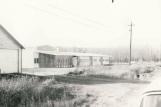 Credits:
Credits:David Leirdal
Fort McMurray Historical Society
19
1960s BoomThe influx of students increased so drastically that more schools were required immediately. The school board's policy was to build a school only when it was necessary, so the problem arose that schools were built for a certain estimated population, without accommodating or preparing for an increase in students over the following years. To accommodate the ever-increasing student population, portables were added to the school grounds and classes had to be held in shifts and in buildings around town.
There were too many students at Peter Pond Public School and St. John's Separate School, so Dr. Clark School and Father J.A. Turcotte were planned for the east end of Franklin Avenue.
The Northland School Division put out a call across Canada, the U.K. and around the world for teachers to come to Fort McMurray. They used an intriguing advertisement, "No weaklings need apply." It worked: many teachers up to the challenge came from far and wide to prove themselves!
Dr. Clark School was named after Dr. Karl A. Clark, who was known for his studies and analyses of the physical and chemical properties of oilsands. An engineering graduate based out of the University of Alberta, he enjoyed teaching and encouraging new engineering students. The school and several other locations in Fort McMurray are named in his honour.
20
P2008.213.1: High school students on the steps of St. John's, 19601960
McMurray, Alberta, Canada
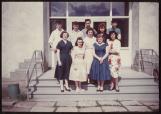 Credits:
Credits:Eileen Ross
Fort McMurray Historical Society
21
P2008.213.2: St. John's School (exterior after additions), circa 19601960
McMurray, Alberta, Canada
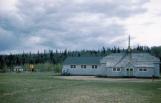 Credits:
Credits:Fort McMurray Historical Society
22
The 1960s1960s-1980s
The following Catholic schools were opened: Father J. A. Turcotte Elementary School, Good Shepherd School, St. Paul's Elementary School, Father Patrick Mercredi Community High School, Father Beauregard Edu-Com Centre, and St. Gabriel School.
1961
The McMurray Public School was closed so that a new school could be built in its place. The old school was burnt down for a volunteer firefighter training session. ** See the Archie Goodwin anecdote in the Storylines and listen to the Real Martin and Roy Hawkins audio clip for the full story.
The new public school, Peter Pond, named after the fur trader, replaced the old McMurray two-room schoolhouse, which had recently been demolished. The new school boasted a small gymnasium, library, stage, staff room, and was the first to offer indoor plumbing as the new modern school in McMurray. Population of McMurray: near 1200.
The McMurray School District #2833 and the St. John's Roman Catholic School District #32 amalgamated under the Northland School Division.
June 1, 1962
"Fort" was added to the Town's name: the Town of Fort McMurray.
June 30, 1964
The Town became the New Town of Fort McMurray.
1965
By 1965, Peter Pond School and St. John's were renovated and expanded to accommodate the increasing enrollment due to the oil sands boom. These changes lasted into the 1980s.
A new adult vocational school was planned to open in September 1965 offering pre-employment courses and basic training in various trades and skills, for example: heavy equipment operation and pipe trades. The maximum enrollment was set at 70 students. This school was originally called the Alberta Vocational Training Centre, and was renamed Keyano College in 1975. It has expanded extensively over the years and now offers many college programs with a particular focus on trades relating to the oilsands business.
1968
Dr. Clark School was constructed and officially opened, but some classes had to be held in Peter Pond School and above Haxton's Store for the first few months until portables and more classrooms were added. Population of Fort McMurray: 5943.
September 1968
Construction began on Father J.A. Turcotte School. It was built next to Dr. Clark School. Students from the two schools competed as rivals on the playground and in sports teams and school events.
September 30: St. John's Roman Catholic School District #32 became the Fort McMurray Roman Catholic Separate School District #32.
1969
January: Father J.A. Turcotte o.m.i. [Oblates of Mary Immaculate] Elementary School opened. J.A. Turcotte was built to relieve St. John's of some students. Turcotte was an elementary school, and at this point, St. John's was a high school.
May 22: The Fort McMurray Public School District finally became independent of the Northland School Division.
December: Peter Pond School was closed early for Christmas break (December 20-21) due to a fire in an overheated chimney from the incinerator in the furnace room. There was damage to the Junior High wing, smoke fumes, and $3000-$5000 worth of damage to the roof.
23
P2007.33.12: Peter Pond School, Grades 4 & 5, 1964-651964-65
Fort McMurray, Alberta, Canada
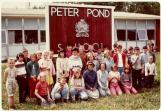 Credits:
Credits:S. Paulsen Collection
Fort McMurray Historical Society
24
The 1970s1972
At the end of 1972, 2386 pupils were attending the local schools. With the continuous growth and development in the area, it became necessary to build more schools in the following years in order to accommodate the growing student population. All four schools: Peter Pond, Dr. K.A. Clark, J.A. Turcotte, and St. John's, as well as the Alberta Vocational Centre, were located in the same area downtown along Franklin Avenue. The district needed to expand outward and provide schools in different locations throughout the growing community.
1974
1002 students were enrolled at Dr. Clark School in 1974, filling it beyond capacity, before another public school, Clearwater School, finally opened to take on the extra students.
Clearwater Elementary School officially opened on May 30 for a capacity of 500 students with 15 classrooms, a library, gymnasium, and a science room.
Both the Public and Separate School Boards decided to use the same architect and contractor in order to speed up the construction process and save money. Public and Separate schools were built next to one another, as was becoming the norm in Fort McMurray. While this created some rivalry between the schools, it was also a matter of convenience for the different areas of the town. St. Paul's and Thickwood Heights Schools were built in the Thickwood Heights area, and Beacon Hill and Good Shepherd Schools were built in Beacon Hill.
August: A joint agreement was signed between the Public and Separate School Boards to build a school together: Composite High School. This new venture was meant to bring the students and school boards together in an effort to create and build on ideas of harmony, cooperation, teamwork, and community within Fort McMurray. Construction was planned to begin in September 1976 with the intention of eventually having 715 students enrolled. There would also be the advantage of the Alberta Vocational School's new auditorium, which the drama students would be allowed to use.
1975
St. Paul's and Good Shepherd Separate Schools were built.
Beacon Hill and Thickwood Heights Public Schools were also constructed.
The Alberta Vocational Training Centre was renamed Keyano College. (Keyano is a Cree word that means "sharing.")
November 17: Good Shepherd School students moved into the school.
December 19: official opening of Good Shepherd School. There were 243 students at first, with 13 teachers, and the school offered kindergarten to grade 6. Grade 7 was added in 1983.
The Frank Spragins School was built in Abasand. It was named after an engineer who researched the oilsands and helped bring about the establishment of Syncrude Canada Limited in 1964. He was also the first President of Syncrude.
In 1974-75, a school was built for children with special needs. Opportunity rooms were already in place in some of the schools in Fort McMurray, but it was necessary to open a school to directly address the needs of these students, and offer programs that were designed to assist the students in becoming more independent. Hillside School was opened for this purpose in Waterways.
1976
March: Thickwood Heights was opened. Thickwood students were originally in portables at Dr. Clark School until they were able to move into the new school.
April 20: St. Paul's Elementary School students moved into the school.
September: Beacon Hill School opened, but classes were conducted in portable classrooms in shifts until the actual school building could be fully occupied.
1977
January: Composite High School opened next to Keyano College. In the first year, approximately 1 in 3 students were Catholic; religion classes were offered.
May 27: official opening of Composite High. 568 students transferred from Peter Pond, which then became Peter Pond Junior High School.
1978
Construction began on Father Beauregard School in Abasand Heights.
Birchwood Junior High School opened in September. It offered French Immersion for Kindergarten to Grade 8.
1979
February 20: students moved into Father Maurice Beauregard o.m.i. [Oblates of Mary Immaculate] Educational Community Centre.
November 16: official candlelight ceremony opening of Father Beauregard.
Gregoire Park School started out as a satellite of Beacon Hill School at the Recreation Centre in a few portables. By 1979, when the school grew larger, a principal was appointed to oversee the students.
25
The 1980s1980
Frank Spragins School begins to offer a French Immersion Program for Kindergarten to Grade 6.
August 1980
St. Gabriel School construction began.
The Fort McMurray Roman Catholic Separate School District #32 became the Fort McMurray Catholic Board of Education. Throughout the 1960s and 1970s, there were problems with funding for the arts, extracurricular activities, administrative department, library, gymnasium, auditorium, and acquiring teachers up north. By 1980, the Fort McMurray Catholic School District was publicly funded through taxation and the provincial government. The Board's objectives included: growth in personal values, Christian faith, and social responsibility.
September 1, 1980
Fort McMurray achieved city status and was renamed: the City of Fort McMurray.
1981
The Good Shepherd Elementary School was renamed the Good Shepherd Community School for having such a great impact on the community, offering programs like the Community Resource Inventory Bank and the Development of Language Arts Skills Through Community Resources Program.
September: St. Gabriel students moved into the school. It was an Elementary-Junior High School that was opened in Thickwood Heights. It started out only going up to grade 7, but grade 8 was added in 1982 and grade 9 in 1983. By 1983, the school almost doubled in size with additional classrooms, portables, a new library, industrial arts and home economics rooms.
By September, St. Paul's Elementary School had expanded to include grade 7, classrooms and portables had been added, a French Immersion program was introduced, and the school offered Girl Guides, Outdoor Education, Computer Education, music programs, sports practices, and fitness classes in the evenings. Enrollment had increased to over 400, and continued to increase to 580 by 1985.
Enrollment at Composite High School was over capacity at 1171 students. The joint venture dissolved and over 700 Catholic students transferred to the new school, Father Patrick Mercredi Community High School.
September 1982
Students started attending Father Patrick Mercredi Community High School.
November 1: Father Mercredi School officially opened. The school's main objective was to have students and the community working together. The school offered an extensive range of facilities, including: a large cafeteria, 2 gyms, a community library, music, arts, and drama rooms, a theatre, chapel, computer labs, industrial arts, automotive and construction rooms, a beauty culture lab, a home economics centre, a printing and commercial arts room, a lounge area, as well as many offices, classrooms, and ancillary rooms. There were no school bells between classes, offering the students a sense of trust, maturity, responsibility, and time management. The students were strongly encouraged to pursue career goals and further academia.
Father Patrick Mercredi was involved within the community as a leader, coach, athlete, artist, and he loved children. Father Mercredi, originally from Fort Chipewyan, became the second Native priest in Alberta in 1934. He lived and worked in Manitoba, Saskatchewan, and Northern Alberta for most of his life. He passed away just the day before his namesake school opened in 1982; his legacy still lives on today.
École Dickinsfield opened for the 1982-83 school year.
November 18, 1983
St. Anne's School officially opened. Construction began at the beginning of the year, and students moved in on September 3, 1983. This was the eighth Catholic school and it is located in Timberlea. The school offered classes from kindergarten to grade 9.
1984
École Dickinsfield began to offer French Immersion Programs for Kindergarten to Grade 8
1985
Peter Pond School was changed to Peter Pond Junior High School.
1986
A new high school opened in Thickwood called Westwood Community High School.
c. 1987
Westview Public School opened around this time in Thickwood, and Greely Road Public School opened in Gregoire.
1987-88
Fort McMurray Public School District #2833 consisted of 13 public schools by 1988 with approximately 4700 students enrolled:
Beacon Hill Public School
Birchwood Public School
Clearwater Public School
Dickinsfield Public School
Dr. K. A. Clark Public School
Fort McMurray Composite High School
Frank Spragins Public School
Greely Road Public School
Peter Pond Public School
Thickwood Heights Public School
Timberlea Public School
Westview Public School
Westwood Community High School
1988
Timberlea Public School opened in Timberlea.
26
Annexation History of Fort McMurrayOctober 1990
Fort McMurray, Alberta, Canada
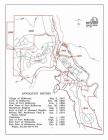 Credits:
Credits:Regional Municipality of Wood Buffalo
Fort McMurray Historical Society
27
The 1990s to Presentc. 1990
Moberly Hall Charter School opened in Gregoire.
1992
Second Chance School opened in Thickwood.
1993
Sister Mary Phillips School was built in Dickinsfield.
September: Fort McMurray Christian School opened in Thickwood. This was an attempt to replace the Maranatha Christian School that was in operation from circa 1985 until it closed in June 1992. The school has a ratio of fifteen students to one teacher, with students of varying ages and grade levels in the same classroom, similar to the concept of a one-room schoolhouse.
November 26: official opening of the Fort McMurray Christian School.
1995
Peter Pond School closed.
The closure of St. John's was also approved.
Frank Spragins Elementary School and Clearwater School also closed.
April 1: the City of Fort McMurray and Improvement District No. 18N merged to form the Municipality of Wood Buffalo.
1999
Conseil scolaire Centre-Nord bought the École Boreal Centre.
August 2004
Dr. Karl A. Clark School underwent renovations and improvements in the summer of 2004.
The top priority at this point is a new school in Timberlea, as well as renovation requests for Beacon Hill, Composite High School, Thickwood Heights, and Westview.
2005
Fort McMurray Public School District opened the Fort McMurray Islamic School on Greely Road.
2006
St. Martha School opened in Timberlea.
2007
June: Second Chance School, open since circa 1992, was renamed Frank Spragins School. Its name had already been changed to Clearwater Alternative High School, went back to Second Chance School, and is now taking the name from the previous Frank Spragins school to further honour Spragins as a local hero.
Birchwood School closed and became the YMCA Birchwood Childhood Development Centre.
September 2011
École McTavish Junior High School opened in Timberlea. Named in honour of Mr. and Mrs. McTavish.
Holy Trinity High School opened in Timberlea.